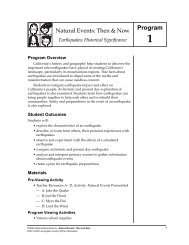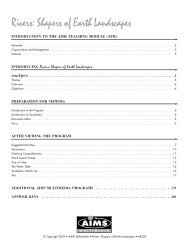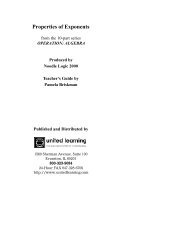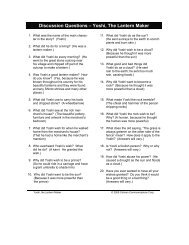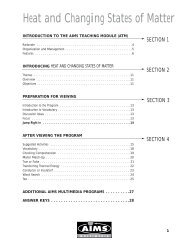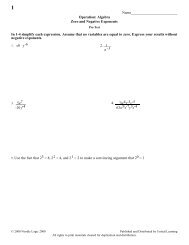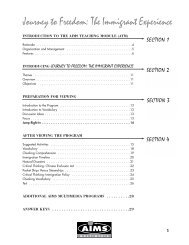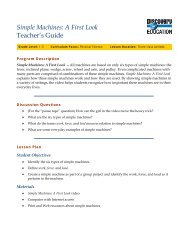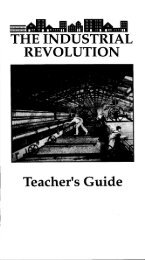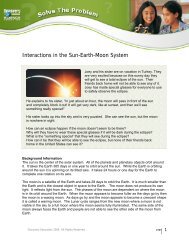Ecosystems: Nature in Balance
Ecosystems: Nature in Balance
Ecosystems: Nature in Balance
Create successful ePaper yourself
Turn your PDF publications into a flip-book with our unique Google optimized e-Paper software.
<strong>Ecosystems</strong>: <strong>Nature</strong> <strong>in</strong> <strong>Balance</strong><br />
INTRODUCTION TO THE AIMS TEACHING MODULE (ATM)<br />
Rationale . . . . . . . . . . . . . . . . . . . . . . . . . . . . . . . . . . . . . . . . . . . . . . . . . . .4<br />
Organization and Management . . . . . . . . . . . . . . . . . . . . . . . . . . . . . . . . . . . .5<br />
Features . . . . . . . . . . . . . . . . . . . . . . . . . . . . . . . . . . . . . . . . . . . . . . . . . . . .6<br />
INTRODUCING ECOSYSTEMS: NATURE IN BALANCE<br />
Themes . . . . . . . . . . . . . . . . . . . . . . . . . . . . . . . . . . . . . . . . . . . . . . . . . . . .11<br />
Overview . . . . . . . . . . . . . . . . . . . . . . . . . . . . . . . . . . . . . . . . . . . . . . . . . .11<br />
Objectives . . . . . . . . . . . . . . . . . . . . . . . . . . . . . . . . . . . . . . . . . . . . . . . . . .11<br />
PREPARATION FOR VIEWING<br />
Introduction to the Program . . . . . . . . . . . . . . . . . . . . . . . . . . . . . . . . . . . . . .13<br />
Introduction to Vocabulary . . . . . . . . . . . . . . . . . . . . . . . . . . . . . . . . . . . . . . .13<br />
Discussion Ideas . . . . . . . . . . . . . . . . . . . . . . . . . . . . . . . . . . . . . . . . . . . . . .13<br />
Focus . . . . . . . . . . . . . . . . . . . . . . . . . . . . . . . . . . . . . . . . . . . . . . . . . . . . .13<br />
Jump Right In . . . . . . . . . . . . . . . . . . . . . . . . . . . . . . . . . . . . . .14<br />
AFTER VIEWING THE PROGRAM<br />
Suggested Activities . . . . . . . . . . . . . . . . . . . . . . . . . . . . . . . . . . . . . . . . . . .15<br />
Vocabulary . . . . . . . . . . . . . . . . . . . . . . . . . . . . . . . . . . . . . . . . . . . . . . . . .19<br />
Check<strong>in</strong>g Comprehension . . . . . . . . . . . . . . . . . . . . . . . . . . . . . . . . . . . . . . .20<br />
Food Cha<strong>in</strong> . . . . . . . . . . . . . . . . . . . . . . . . . . . . . . . . . . . . . . . . . . . . . . . . .21<br />
A Food Cha<strong>in</strong> Game . . . . . . . . . . . . . . . . . . . . . . . . . . . . . . . . . . . . . . . . . .22<br />
Gett<strong>in</strong>g the Mean<strong>in</strong>g from Context . . . . . . . . . . . . . . . . . . . . . . . . . . . . . . . . .23<br />
Food Makers . . . . . . . . . . . . . . . . . . . . . . . . . . . . . . . . . . . . . . . . . . . . . . . .24<br />
Acrostics . . . . . . . . . . . . . . . . . . . . . . . . . . . . . . . . . . . . . . . . . . . . . . . . . . .25<br />
<strong>Ecosystems</strong> at Work I . . . . . . . . . . . . . . . . . . . . . . . . . . . . . . . . . . . . . . . . . .26<br />
<strong>Ecosystems</strong> at Work II . . . . . . . . . . . . . . . . . . . . . . . . . . . . . . . . . . . . . . . . . .27<br />
<strong>Ecosystems</strong> at Work III . . . . . . . . . . . . . . . . . . . . . . . . . . . . . . . . . . . . . . . . .28<br />
Check<strong>in</strong>g Vocabulary . . . . . . . . . . . . . . . . . . . . . . . . . . . . . . . . . . . . . . . . . .29<br />
Test . . . . . . . . . . . . . . . . . . . . . . . . . . . . . . . . . . . . . . . . . . . . . . . . . . . . . . .30<br />
ADDITIONAL AIMS MEDIA PROGRAMS . . . . . . . . . . . . . .31<br />
ADDITIONAL READING SUGGESTIONS . . . . . . . . . . . . . .31<br />
ANSWER KEY . . . . . . . . . . . . . . . . . . . . . . . . . . . . . . . . .32<br />
1
© Copyright 1994 AIMS Media A Multimedia Group<br />
All Rights Reserved. No part of this work may be reproduced or transmitted without written permission of AIMS Media with<br />
these exceptions: Persons or schools purchas<strong>in</strong>g this AIMS Teach<strong>in</strong>g Module may reproduce consumable ATM pages,<br />
identified <strong>in</strong> Section 4, for student or classroom use.<br />
AIMS Media is a lead<strong>in</strong>g producer and distributor of educational programs serv<strong>in</strong>g schools and libraries for<br />
nearly 40 years. AIMS draws upon the most up-to-date knowledge, exist<strong>in</strong>g and emerg<strong>in</strong>g technologies, and<br />
all of the <strong>in</strong>structional and pedagogical resources available to develop and distribute educational programs <strong>in</strong><br />
film, videocassette, laserdisc, CD-ROM and CD-i formats.<br />
Persons or schools <strong>in</strong>terested <strong>in</strong> obta<strong>in</strong><strong>in</strong>g additional copies of this AIMS Teach<strong>in</strong>g Module, please contact:<br />
AIMS Media<br />
1-800-FOR-AIMS<br />
1-800-367-2467<br />
AIMS TEACHING MODULE WRITTEN BY JULIE KOERNER<br />
2
Congratulations!<br />
You have chosen a learn<strong>in</strong>g program<br />
that will actively motivate your students<br />
AND provide you with easily accessible<br />
and easily manageable <strong>in</strong>structional<br />
guidel<strong>in</strong>es designed to make your<br />
teach<strong>in</strong>g role efficient and reward<strong>in</strong>g.<br />
The AIMS Teach<strong>in</strong>g Module provides<br />
you with a video program keyed<br />
to your classroom curriculum,<br />
<strong>in</strong>structions and guidel<strong>in</strong>es for use,<br />
plus a comprehensive teach<strong>in</strong>g<br />
program conta<strong>in</strong><strong>in</strong>g a wide range<br />
of activities and ideas for <strong>in</strong>teraction<br />
between all content areas. Our<br />
authors, educators, and consultants<br />
have written and reviewed the AIMS<br />
Teach<strong>in</strong>g Modules to align with the<br />
Educate America Act: Goals 2000.<br />
This ATM, with its clear def<strong>in</strong>ition of<br />
manageability, both <strong>in</strong> the classroom<br />
and beyond, allows you to tailor<br />
specific activities to meet all of your<br />
classroom needs.<br />
© Copyright 1994 AIMS Media A Multimedia Group<br />
3
RATIONALE<br />
In today’s classrooms, educational<br />
pedagogy is often founded on<br />
Benjam<strong>in</strong> S. Bloom’s “Six Levels of<br />
Cognitive Complexity.” The practical<br />
application of Bloom’s Taxonomy is<br />
to evaluate students’ th<strong>in</strong>k<strong>in</strong>g skills on<br />
these levels, from the simple to the<br />
complex: Knowledge (rote memory<br />
skills), Comprehension (the ability to<br />
relate or retell), Application (the ability<br />
to apply knowledge outside its orig<strong>in</strong>),<br />
Analysis (relat<strong>in</strong>g and differentiat<strong>in</strong>g<br />
parts of a whole), Synthesis (relat<strong>in</strong>g<br />
parts to a whole), and Evaluation<br />
(mak<strong>in</strong>g a judgment or formulat<strong>in</strong>g<br />
an op<strong>in</strong>ion).<br />
The AIMS Teach<strong>in</strong>g Module is<br />
designed to facilitate these <strong>in</strong>tellectual<br />
capabilities, AND to <strong>in</strong>tegrate<br />
classroom experiences and<br />
assimilation of learn<strong>in</strong>g with the<br />
students’ life experiences, realities, and<br />
expectations. AIMS’ learner verification<br />
studies prove that our AIMS Teach<strong>in</strong>g<br />
Modules help students to absorb,<br />
reta<strong>in</strong>, and to demonstrate ability to<br />
use new knowledge <strong>in</strong> their world.<br />
Our educational materials are written<br />
and designed for today’s classroom,<br />
which <strong>in</strong>corporates a wide range of<br />
<strong>in</strong>tellectual, cultural, physical, and<br />
emotional diversities.<br />
4<br />
© Copyright 1994 AIMS Media A Multimedia Group
ORGANIZATION AND<br />
MANAGEMENT<br />
To facilitate ease <strong>in</strong> classroom<br />
manageability, the AIMS Teach<strong>in</strong>g<br />
Module is organized <strong>in</strong> four sections,<br />
identifiable by their color across the<br />
top of the page and at the side tab<br />
marg<strong>in</strong>. You are read<strong>in</strong>g SECTION 1,<br />
INTRODUCTION TO THE AIMS<br />
TEACHING MODULE (ATM).<br />
SECTION 2,<br />
INTRODUCING THIS ATM<br />
will give you the specific <strong>in</strong>formation<br />
you need to <strong>in</strong>tegrate the program <strong>in</strong>to<br />
your classroom curriculum.<br />
SECTION 3,<br />
PREPARATION FOR VIEWING<br />
provides suggestions and strategies for<br />
motivation, language preparedness,<br />
read<strong>in</strong>ess, and focus prior to view<strong>in</strong>g<br />
the program with your students.<br />
SECTION 4,<br />
AFTER VIEWING THE PROGRAM<br />
provides suggestions for additional<br />
activities plus an assortment of<br />
consumable assessment and extended<br />
activities, designed to broaden<br />
comprehension of the topic and to<br />
make connections to other curriculum<br />
content areas.<br />
© Copyright 1994 AIMS Media A Multimedia Group<br />
5
FEATURES<br />
INTRODUCING EACH ATM<br />
SECTION 2<br />
Your AIMS Teach<strong>in</strong>g Module is<br />
designed to accompany a video<br />
program written and produced by<br />
some of the world’s most credible<br />
and creative writers and producers<br />
of educational programm<strong>in</strong>g. To<br />
facilitate diversity and flexibility <strong>in</strong><br />
your classroom, your AIMS Teach<strong>in</strong>g<br />
Module features these components:<br />
Themes<br />
The Major Theme tells how this AIMS<br />
Teach<strong>in</strong>g Module is keyed <strong>in</strong>to the<br />
curriculum. Related Themes offer<br />
suggestions for <strong>in</strong>teraction with other<br />
curriculum content areas, enabl<strong>in</strong>g<br />
teachers to use the teach<strong>in</strong>g module<br />
to <strong>in</strong>corporate the topic <strong>in</strong>to a variety<br />
of learn<strong>in</strong>g areas.<br />
Overview<br />
The Overview provides a synopsis of<br />
content covered <strong>in</strong> the video program.<br />
Its purpose is to give you a summary<br />
of the subject matter and to enhance<br />
your <strong>in</strong>troductory preparation.<br />
Objectives<br />
The ATM learn<strong>in</strong>g objectives provide<br />
guidel<strong>in</strong>es for teachers to assess what<br />
learners can be expected to ga<strong>in</strong> from<br />
each program. After completion of the<br />
AIMS Teach<strong>in</strong>g Module, your students<br />
will be able to demonstrate dynamic<br />
and applied comprehension of<br />
the topic.<br />
6<br />
© Copyright 1994 AIMS Media A Multimedia Group
PREPARATION FOR VIEWING<br />
SECTION 3<br />
In preparation for view<strong>in</strong>g the<br />
video program, the AIMS Teach<strong>in</strong>g<br />
Module offers activity and/or<br />
discussion ideas that you may use<br />
<strong>in</strong> any order or comb<strong>in</strong>ation.<br />
Introduction To The Program<br />
Introduction to the Program is<br />
designed to enable students to recall<br />
or relate prior knowledge about the<br />
topic and to prepare them for what<br />
they are about to learn.<br />
Introduction To Vocabulary<br />
Introduction to Vocabulary is a<br />
review of language used <strong>in</strong> the<br />
program: words, phrases, usage.<br />
This vocabulary <strong>in</strong>troduction is<br />
designed to ensure that all learners,<br />
<strong>in</strong>clud<strong>in</strong>g limited English proficiency<br />
learners, will have full understand<strong>in</strong>g<br />
of the language usage <strong>in</strong> the content<br />
of the program.<br />
Discussion Ideas<br />
Discussion Ideas are designed to<br />
help you assess students’ prior<br />
knowledge about the topic and to<br />
give students a preview of what<br />
they will learn. Active discussion<br />
stimulates <strong>in</strong>terest <strong>in</strong> a subject and<br />
can motivate even the most reluctant<br />
learner. Listen<strong>in</strong>g, as well as speak<strong>in</strong>g,<br />
is active participation. Encourage<br />
your students to participate at the<br />
rate they feel comfortable. Model<br />
shar<strong>in</strong>g personal experiences when<br />
applicable, and model listen<strong>in</strong>g to<br />
students’ ideas and op<strong>in</strong>ions.<br />
Focus<br />
Help learners set a purpose for<br />
watch<strong>in</strong>g the program with Focus,<br />
designed to give students a focal<br />
po<strong>in</strong>t for comprehension cont<strong>in</strong>uity.<br />
Jump Right In<br />
Jump Right In provides abbreviated<br />
<strong>in</strong>structions for quick management<br />
of the program.<br />
AFTER VIEWING THE PROGRAM<br />
SECTION 4<br />
After your students have viewed<br />
the program, you may <strong>in</strong>troduce<br />
any or all of these activities to<br />
<strong>in</strong>teract with other curriculum content<br />
areas, provide re<strong>in</strong>forcement, assess<br />
comprehension skills, or provide<br />
hands-on and <strong>in</strong>-depth extended<br />
study of the topic.<br />
© Copyright 1994 AIMS Media A Multimedia Group<br />
7
SUGGESTED<br />
ACTIVITIES<br />
The Suggested Activities offer ideas<br />
for activities you can direct <strong>in</strong> the<br />
classroom or have your students<br />
complete <strong>in</strong>dependently, <strong>in</strong> pairs, or<br />
<strong>in</strong> small work groups after they have<br />
viewed the program. To accommodate<br />
your range of classroom needs, the<br />
activities are organized <strong>in</strong>to skills<br />
categories. Their labels will tell you<br />
how to identify each activity and help<br />
you correlate it <strong>in</strong>to your classroom<br />
curriculum. To help you schedule<br />
your classroom lesson time, the<br />
AIMS hourglass gives you an estimate<br />
of the time each activity should<br />
require. Some of the activities fall<br />
<strong>in</strong>to these categories:<br />
Meet<strong>in</strong>g Individual<br />
Needs<br />
These activities are designed to aid<br />
<strong>in</strong> classroom cont<strong>in</strong>uity. Reluctant<br />
learners and learners acquir<strong>in</strong>g<br />
English will benefit from these activities<br />
geared to enhance comprehension<br />
of language <strong>in</strong> order to fully grasp<br />
content mean<strong>in</strong>g.<br />
MATH<br />
Curriculum Connections<br />
Critical Th<strong>in</strong>k<strong>in</strong>g<br />
Critical Th<strong>in</strong>k<strong>in</strong>g activities are<br />
designed to stimulate learners’ own<br />
op<strong>in</strong>ions and ideas. These activities<br />
require students to use the th<strong>in</strong>k<strong>in</strong>g<br />
process to discern fact from op<strong>in</strong>ion,<br />
consider their own problems and<br />
formulate possible solutions, draw<br />
conclusions, discuss cause and effect,<br />
or comb<strong>in</strong>e what they already know<br />
with what they have learned to<br />
make <strong>in</strong>ferences.<br />
Cultural Diversity<br />
Each AIMS Teach<strong>in</strong>g Module has an<br />
activity called Cultural Awareness,<br />
Cultural Diversity, or Cultural<br />
Exchange that encourages students<br />
to share their backgrounds, cultures,<br />
heritage, or knowledge of other<br />
countries, customs, and language.<br />
Hands On<br />
These are experimental or tactile<br />
activities that relate directly to the<br />
material taught <strong>in</strong> the program.Your<br />
students will have opportunities to<br />
make discoveries and formulate ideas<br />
on their own, based on what they<br />
learn <strong>in</strong> this unit.<br />
In The Newsroom<br />
Each AIMS Teach<strong>in</strong>g Module conta<strong>in</strong>s<br />
a newsroom activity designed to help<br />
students make the relationship between<br />
what they learn <strong>in</strong> the classroom and<br />
how it applies <strong>in</strong> their world. The<br />
purpose of In The Newsroom is to<br />
actively <strong>in</strong>volve each class member <strong>in</strong><br />
a whole learn<strong>in</strong>g experience. Each<br />
student will have an opportunity to<br />
perform all of the tasks <strong>in</strong>volved <strong>in</strong><br />
production: writ<strong>in</strong>g, research<strong>in</strong>g,<br />
produc<strong>in</strong>g, direct<strong>in</strong>g, and <strong>in</strong>terview<strong>in</strong>g<br />
as they create their own classroom<br />
news program.<br />
Extended Activities<br />
These activities provide opportunities<br />
for students to work separately or<br />
together to conduct further research,<br />
explore answers to their own<br />
questions, or apply what they<br />
have learned to other media or<br />
content areas.<br />
L<strong>in</strong>k to the World<br />
These activities offer ideas for<br />
connect<strong>in</strong>g learners’ classroom<br />
activities to their community and<br />
the rest of the world.<br />
Many of the suggested activities are<br />
<strong>in</strong>tended to <strong>in</strong>tegrate the content of<br />
the ATM program <strong>in</strong>to other content<br />
areas of the classroom curriculum.<br />
These cross-connections turn the<br />
classroom teach<strong>in</strong>g experience <strong>in</strong>to<br />
a whole learn<strong>in</strong>g experience.<br />
Writ<strong>in</strong>g<br />
Every AIMS Teach<strong>in</strong>g Module will<br />
conta<strong>in</strong> an activity designed for<br />
students to use the writ<strong>in</strong>g process<br />
to express their ideas about what they<br />
have learned. The writ<strong>in</strong>g activity may<br />
also help them to make the connection<br />
between what they are learn<strong>in</strong>g <strong>in</strong><br />
this unit and how it applies to other<br />
content areas.<br />
Culm<strong>in</strong>at<strong>in</strong>g Activity<br />
To wrap up the unit, AIMS Teach<strong>in</strong>g<br />
Modules offer suggestions for ways<br />
to re<strong>in</strong>force what students have<br />
learned and how they can use their<br />
new knowledge to enhance their<br />
world view.<br />
8<br />
© Copyright 1994 AIMS Media A Multimedia Group
VOCABULARY<br />
Every ATM conta<strong>in</strong>s an activity that<br />
re<strong>in</strong>forces the mean<strong>in</strong>g and usage of<br />
the vocabulary words <strong>in</strong>troduced <strong>in</strong><br />
the program content. Students will<br />
either read or f<strong>in</strong>d the def<strong>in</strong>ition of<br />
each vocabulary word, then use the<br />
word <strong>in</strong> a written sentence.<br />
CHECKING<br />
COMPREHENSION<br />
Check<strong>in</strong>g Comprehension is designed<br />
to help you evaluate how well your<br />
students understand, reta<strong>in</strong>, and recall<br />
the <strong>in</strong>formation presented <strong>in</strong> the AIMS<br />
Teach<strong>in</strong>g Module. Depend<strong>in</strong>g on your<br />
students’ needs, you may direct this<br />
activity to the whole group yourself,<br />
or you may want to have students work<br />
on the activity page <strong>in</strong>dependently, <strong>in</strong><br />
pairs, or <strong>in</strong> small groups. Students can<br />
verify their written answers through<br />
discussion or by view<strong>in</strong>g the video<br />
a second time. If you choose, you can<br />
reproduce the answers from your<br />
Answer Key or write the answer<br />
choices <strong>in</strong> a Word Bank for students<br />
to use. Students can use this completed<br />
activity as a study guide to prepare<br />
for the test.<br />
CONSUMABLE<br />
ACTIVITIES<br />
The AIMS Teach<strong>in</strong>g Module provides<br />
a selection of consumable activities,<br />
designed to specifically re<strong>in</strong>force the<br />
content of this learn<strong>in</strong>g unit. Whenever<br />
applicable, they are arranged <strong>in</strong><br />
order from low to high difficulty level,<br />
to allow a seamless facilitation of the<br />
learn<strong>in</strong>g process. You may choose to<br />
have students take these activities<br />
home or to work on them <strong>in</strong> the<br />
classroom <strong>in</strong>dependently, <strong>in</strong> pairs<br />
or <strong>in</strong> small groups.<br />
CHECKING<br />
VOCABULARY<br />
The Check<strong>in</strong>g Vocabulary activity<br />
provides the opportunity for students<br />
to assess their knowledge of new<br />
vocabulary with this word game or<br />
puzzle. The format of this vocabulary<br />
activity allows students to use the<br />
related words and phrases <strong>in</strong> a<br />
different context.<br />
TEST<br />
The AIMS Teach<strong>in</strong>g Module Test<br />
permits you to assess students’<br />
understand<strong>in</strong>g of what they have<br />
learned. The test is formatted <strong>in</strong><br />
one of several standard test formats<br />
to give your students a range of<br />
experiences <strong>in</strong> test-tak<strong>in</strong>g techniques.<br />
Be sure to read, or rem<strong>in</strong>d students<br />
to read, the directions carefully<br />
and to read each answer choice<br />
before mak<strong>in</strong>g a selection. Use the<br />
Answer Key to check their answers.<br />
© Copyright 1994 AIMS Media A Multimedia Group<br />
9
ADDITIONAL AIMS<br />
MEDIA PROGRAMS<br />
After you have completed this AIMS<br />
Teach<strong>in</strong>g Module you may be <strong>in</strong>terested<br />
<strong>in</strong> more of the programs that AIMS<br />
offers. This list <strong>in</strong>cludes several related<br />
AIMS programs.<br />
ADDITIONAL READING<br />
SUGGESTIONS<br />
AIMS offers a carefully researched list<br />
of other resources that you and your<br />
students may f<strong>in</strong>d reward<strong>in</strong>g.<br />
ANSWER KEY<br />
Reproduces tests and work pages<br />
with answers marked to all activities<br />
and tests.<br />
10<br />
© Copyright 1994 AIMS Media A Multimedia Group
<strong>Ecosystems</strong>: <strong>Nature</strong> <strong>in</strong> <strong>Balance</strong><br />
THEMES<br />
The study of ecosystems is an <strong>in</strong>tegral<br />
part of the classroom curriculum <strong>in</strong> life<br />
science. The major theme is the<br />
<strong>in</strong>teraction of organisms. Related<br />
themes <strong>in</strong>clude relationships among<br />
liv<strong>in</strong>g th<strong>in</strong>gs; natural resources<br />
and human responsibilities to an<br />
ecosystem.<br />
OVERVIEW<br />
<strong>Ecosystems</strong>: <strong>Nature</strong> <strong>in</strong> <strong>Balance</strong> provides<br />
students with a clear def<strong>in</strong>ition of an<br />
ecosystem – plants, animals, and their<br />
environment – by show<strong>in</strong>g a wide range<br />
of ecosystems and illustrat<strong>in</strong>g how the<br />
liv<strong>in</strong>g and non-liv<strong>in</strong>g th<strong>in</strong>gs <strong>in</strong>teract to<br />
make the ecosystem work effectively. The<br />
program demonstrates how energy from<br />
the sun is used by plants to produce<br />
food, beg<strong>in</strong>n<strong>in</strong>g the cont<strong>in</strong>uous cycle of<br />
the food cha<strong>in</strong>. Students will learn to<br />
dist<strong>in</strong>guish producers from consumers,<br />
and about the importance of decomposers<br />
to the food cha<strong>in</strong>. By learn<strong>in</strong>g to identify<br />
an ecosystem and how it uses energy to<br />
thrive, students will comprehend and<br />
appreciate the importance of preserv<strong>in</strong>g<br />
the natural balance of our environment.<br />
OBJECTIVES<br />
<br />
<br />
To def<strong>in</strong>e and identify an ecosystem<br />
To expla<strong>in</strong> the process of turn<strong>in</strong>g<br />
energy from the sun <strong>in</strong>to the food<br />
cha<strong>in</strong> cycle<br />
<br />
<br />
<br />
To dist<strong>in</strong>guish between producers<br />
and consumers, and to recognize<br />
and def<strong>in</strong>e decomposers<br />
To expla<strong>in</strong> how the removal or<br />
elim<strong>in</strong>ation of one part of an<br />
ecosystem can harm the whole<br />
ecosystem<br />
To describe a biosphere<br />
© Copyright 1994 AIMS Media A Multimedia Group <strong>Ecosystems</strong>: <strong>Nature</strong> In <strong>Balance</strong><br />
11
Use this page for your <strong>in</strong>dividual notes about plann<strong>in</strong>g and/or effective ways to manage this<br />
AIMS Teach<strong>in</strong>g Module <strong>in</strong> your classroom.<br />
Our AIMS Media Educational Department welcomes your observations and comments.<br />
Please feel free to address your correspondence to:<br />
AIMS Media<br />
Editorial Department<br />
9710 DeSoto Avenue<br />
Chatsworth, California 91311-4409<br />
12<br />
© Copyright 1994 AIMS Media A Multimedia Group <strong>Ecosystems</strong>: <strong>Nature</strong> In <strong>Balance</strong>
INTRODUCTION TO<br />
THE PROGRAM<br />
To f<strong>in</strong>d out what students already know<br />
about liv<strong>in</strong>g th<strong>in</strong>gs, ask: “What do liv<strong>in</strong>g<br />
th<strong>in</strong>gs need to survive” Elicit responses<br />
they have already learned about: air,<br />
sunlight, food. Encourage students to<br />
expand their knowledge by discuss<strong>in</strong>g<br />
different needs required by different<br />
liv<strong>in</strong>g th<strong>in</strong>gs. Expla<strong>in</strong> that <strong>in</strong> <strong>Ecosystems</strong>:<br />
<strong>Nature</strong> <strong>in</strong> <strong>Balance</strong>, they will learn about<br />
liv<strong>in</strong>g th<strong>in</strong>gs and their environment, and<br />
how they work together to create an<br />
ecosystem.<br />
INTRODUCTION TO<br />
VOCABULARY<br />
DISCUSSION IDEAS<br />
Ask students to th<strong>in</strong>k about animals and<br />
where they live. Encourage discussion<br />
about the environment and circumstances<br />
surround<strong>in</strong>g different animals: where<br />
and how they get their food and f<strong>in</strong>d<br />
shelter. Tell students they are go<strong>in</strong>g to<br />
see how animals and all liv<strong>in</strong>g th<strong>in</strong>gs<br />
contribute to an ecosystem.<br />
FOCUS<br />
Tell students to watch <strong>Ecosystems</strong>:<br />
<strong>Nature</strong> <strong>in</strong> <strong>Balance</strong> and prepare to<br />
describe the ecosytems around them.<br />
To prepare students for view<strong>in</strong>g<br />
<strong>Ecosystems</strong>: <strong>Nature</strong> <strong>in</strong> <strong>Balance</strong>, present<br />
these words for review: pond,<br />
relationship, diet, stor<strong>in</strong>g (store), network,<br />
pollen, poll<strong>in</strong>ate, preserve, reproduce,<br />
nutrients. Have students volunteer to<br />
provide the def<strong>in</strong>itions, or to work <strong>in</strong><br />
pairs or small groups to f<strong>in</strong>d their<br />
mean<strong>in</strong>gs and report them to the class.<br />
© Copyright 1994 AIMS Media A Multimedia Group <strong>Ecosystems</strong>: <strong>Nature</strong> In <strong>Balance</strong><br />
13
JUMP RIGHT IN<br />
HOW TO USE THE ECOSYSTEMS: NATURE IN BALANCE AIMS TEACHING MODULE<br />
Preparation<br />
<br />
<br />
Read <strong>Ecosystems</strong>: <strong>Nature</strong> In<br />
<strong>Balance</strong> Themes, Overview,<br />
and Objectives to become familiar<br />
with program content and<br />
expectations.<br />
Use Preparation for View<strong>in</strong>g<br />
suggestions to <strong>in</strong>troduce the topic<br />
to students.<br />
View<strong>in</strong>g ECOSYSTEMS<br />
<br />
<br />
<br />
Set up view<strong>in</strong>g monitor so that all<br />
students have a clear view.<br />
Depend<strong>in</strong>g on your classroom<br />
size and learn<strong>in</strong>g range, you<br />
may choose to have students<br />
view <strong>Ecosystems</strong>: <strong>Nature</strong> In<br />
<strong>Balance</strong> together or <strong>in</strong> small<br />
groups.<br />
Some students may benefit from<br />
view<strong>in</strong>g the video more than one<br />
time.<br />
After View<strong>in</strong>g ECOSYSTEMS<br />
<br />
<br />
Select Suggested Activities<br />
that <strong>in</strong>tegrate <strong>in</strong>to your classroom<br />
curriculum. If applicable, gather<br />
materials or resources.<br />
Choose the best way for students<br />
to work on each activity. Some<br />
activities work best for the whole<br />
group.Other activities are designed<br />
for students to work <strong>in</strong>dependently,<br />
<strong>in</strong> pairs, or <strong>in</strong> small groups.<br />
Whenever possible, encourage<br />
students to share their work with<br />
the rest of the group.<br />
<br />
<br />
<br />
<br />
Duplicate the appropriate<br />
number of Vocabulary,<br />
Check<strong>in</strong>g Comprehension,<br />
and consumable activity pages<br />
for your students.<br />
You may choose to have students<br />
take consumable activities home,<br />
or complete them <strong>in</strong> the classroom,<br />
<strong>in</strong>dependently, or <strong>in</strong> groups.<br />
Adm<strong>in</strong>ister the Test to assess<br />
students’ comprehension of<br />
what they have learned, and<br />
to provide them with practice<br />
<strong>in</strong> test-tak<strong>in</strong>g procedures.<br />
Use the Culm<strong>in</strong>at<strong>in</strong>g Activity<br />
as a forum for students to display,<br />
summarize, extend, or share what<br />
they have learned with each other,<br />
the rest of the school, or a local<br />
community organization.<br />
14<br />
© Copyright 1994 AIMS Media A Multimedia Group <strong>Ecosystems</strong>: <strong>Nature</strong> In <strong>Balance</strong>
SUGGESTED ACTIVITIES<br />
Meet<strong>in</strong>g Individual Needs<br />
Br<strong>in</strong>g <strong>in</strong>, or have student volunteers f<strong>in</strong>d, pictures of different plants and animals. Show<br />
each picture and have students identify it, first tell<strong>in</strong>g whether it is plant or animal, then<br />
say<strong>in</strong>g its name. Encourage discussion about liv<strong>in</strong>g th<strong>in</strong>gs by ask<strong>in</strong>g: What about all<br />
the items <strong>in</strong> these pictures is THE SAME What is DIFFERENT To further re<strong>in</strong>force the<br />
concept that all are liv<strong>in</strong>g th<strong>in</strong>gs that can be classified as either plants or animals, you<br />
may want to have students make a classroom display show<strong>in</strong>g pictures, or writ<strong>in</strong>g the<br />
words for each liv<strong>in</strong>g th<strong>in</strong>g they classify PLANT, and each they classify ANIMAL.<br />
20 M<strong>in</strong>utes<br />
Cultural Diversity<br />
Ask students who have visited other countries or moved to your town from another<br />
country to discuss the k<strong>in</strong>ds of animals they know about that live <strong>in</strong> different parts of<br />
the world. Elicit discussion about animals used for work, as on a ranch or farm.<br />
Encourage students to talk about their experiences.<br />
20 M<strong>in</strong>utes<br />
Hands On<br />
Encourage students to build an aquarium or terrarium for the classroom. Expla<strong>in</strong> the<br />
difference: an aquarium is a tank that holds water and fish or small animals, and a<br />
terrarium is an enclosure for plants and small land animals. Tell students to ensure that<br />
the liv<strong>in</strong>g plants or animals get the required light, air, and moisture for survival. Have<br />
students discuss how and why the liv<strong>in</strong>g th<strong>in</strong>gs <strong>in</strong> their aquarium or terrarium <strong>in</strong>teract<br />
to create an ecosystem.<br />
60 M<strong>in</strong>utes<br />
Extended Activity<br />
Have the students work <strong>in</strong> small groups to f<strong>in</strong>d out everyth<strong>in</strong>g they can about different<br />
types of bodies of water: pond, lake, river, ocean, bay. Tell each group to f<strong>in</strong>d out:<br />
how the body of water is formed and where it is found; what k<strong>in</strong>ds of animal and<br />
plant life grow <strong>in</strong> and around their body of water; how the elements liv<strong>in</strong>g <strong>in</strong> and<br />
surround<strong>in</strong>g their body of water <strong>in</strong>teract to form an ecosystem.<br />
30 M<strong>in</strong>utes<br />
15<br />
© Copyright 1994 AIMS Media A Multimedia Group <strong>Ecosystems</strong>: <strong>Nature</strong> In <strong>Balance</strong>
Connection to Health and Nutrition<br />
HEALTH<br />
AND<br />
NUTRITION<br />
Review with students the mean<strong>in</strong>gs of the vocabulary words producers and<br />
consumers. Ask students “Are human be<strong>in</strong>gs producers of foods, or consumers”<br />
Encourage students to discuss the foods they eat, where they come from, and how<br />
they are prepared. If applicable, talk about the differences between herbivorous,<br />
carnivorous, and omnivorous.<br />
20 M<strong>in</strong>utes<br />
Connection to Drama<br />
Have student volunteers depict what happens to acorns <strong>in</strong> a forest by role-play<strong>in</strong>g<br />
different forest animals. Tell them to use real acorns or choose someth<strong>in</strong>g to<br />
represent acorns, and show how different animals eat or store acorns. One student<br />
can be a squirrel, one student can be a bear, and one student can be an acorn<br />
woodpecker. Encourage students to perform their skit for the rest of the class.<br />
DRAMA<br />
15 M<strong>in</strong>utes<br />
Connection to Language Arts<br />
LANGUAGE<br />
ARTS<br />
Assign students to work <strong>in</strong>dependently or <strong>in</strong> small groups to look up the prefixes<br />
eco- (comb<strong>in</strong><strong>in</strong>g form to mean home), aqua- (water), and terra- (land). Then have<br />
them make a list of words us<strong>in</strong>g the prefix, write their lists on the chalkboard, and<br />
encourage other students to contribute to their word lists.<br />
20 M<strong>in</strong>utes<br />
In the Newsroom<br />
Tell your students their Newsroom assignment will be as Science Reporters, to<br />
prepare a report on erosion and how it affects the earth. Tell the research team<br />
they can look <strong>in</strong> the encyclopedia under “earth” or f<strong>in</strong>d other resources to learn<br />
about erosion. Then have the writers write a science report, and a report<strong>in</strong>g team<br />
give the news report, perhaps with “on-site <strong>in</strong>terviews.” If the equipment is available,<br />
have students make an audio or video record<strong>in</strong>g of their newsroom report for later use.<br />
40 M<strong>in</strong>utes<br />
16<br />
© Copyright 1994 AIMS Media A Multimedia Group <strong>Ecosystems</strong>: <strong>Nature</strong> In <strong>Balance</strong>
Connection to Math<br />
MATH<br />
Give the whole group of students five m<strong>in</strong>utes to bra<strong>in</strong>storm, and name as many liv<strong>in</strong>g<br />
th<strong>in</strong>gs as they can. Ask one or two volunteers to write the list of liv<strong>in</strong>g th<strong>in</strong>gs on poster<br />
board or the chalkboard as they are named. Then have the group work together to<br />
categorize the list of liv<strong>in</strong>g th<strong>in</strong>gs. Let the students select the categories; if they need<br />
guidance, you might want to suggest: Plants, Animals that live <strong>in</strong> the Water, Animals<br />
that Live on Land; or Producers and Consumers. Then have the students compile their<br />
categorized results on a classroom chart.<br />
30 M<strong>in</strong>utes<br />
Writ<strong>in</strong>g<br />
Have students imag<strong>in</strong>e they belong to a hik<strong>in</strong>g club and their job is to write <strong>in</strong>formative<br />
<strong>in</strong>structions for tak<strong>in</strong>g a hike or a nature walk, either <strong>in</strong> your town or a town they<br />
imag<strong>in</strong>e. Tell them their paragraphs should <strong>in</strong>clude: th<strong>in</strong>gs to look for on the hike; safety<br />
precautions for hik<strong>in</strong>g <strong>in</strong> the area; animals or plants they should avoid and why. Tell<br />
students to make an outl<strong>in</strong>e of <strong>in</strong>formation they want to <strong>in</strong>clude, and then write a rough<br />
draft of their hik<strong>in</strong>g <strong>in</strong>structions.<br />
30 M<strong>in</strong>utes<br />
Critical Th<strong>in</strong>k<strong>in</strong>g<br />
Have students work <strong>in</strong>dependently or <strong>in</strong> small groups to th<strong>in</strong>k about what their life<br />
would be like if they were an animal. Tell them they must prepare to tell the group how<br />
they get their food and shelter, what are its dangers and defenses, and to describe the<br />
ecosystem that makes up their environment. If students need ideas, you might suggest:<br />
beaver, shark, elephant, giraffe, prairie dog, ostrich.<br />
20 M<strong>in</strong>utes<br />
L<strong>in</strong>k to the World<br />
Tell students to work <strong>in</strong> groups to research endangered animals and f<strong>in</strong>d out about<br />
laws to protect them. Some endangered animals you might want to suggest are:<br />
California condor, gibbon, blue whale, brown grizzly bear, puma. You can advise<br />
students to use an encyclopedia or other resources for research, or suggest that they<br />
write to the World Wildlife Federation, The Sierra Club, the National Wildlife<br />
Federation, or the Greenpeace Organization.<br />
40 M<strong>in</strong>utes<br />
© Copyright 1994 AIMS Media A Multimedia Group <strong>Ecosystems</strong>: <strong>Nature</strong> In <strong>Balance</strong><br />
17
Connection to Math<br />
MATH<br />
After they have completed their research on endangered animals, have students<br />
graph their f<strong>in</strong>d<strong>in</strong>gs, compar<strong>in</strong>g the numbers of exist<strong>in</strong>g animals 10 years ago<br />
and today.<br />
30 M<strong>in</strong>utes<br />
Writ<strong>in</strong>g<br />
If they have not already done so, have students go back to their <strong>in</strong>formative hik<strong>in</strong>g<br />
<strong>in</strong>structions to reread, revise, and edit. Then have them write the f<strong>in</strong>al draft.<br />
30 M<strong>in</strong>utes<br />
Culm<strong>in</strong>at<strong>in</strong>g Activity<br />
Have the group work together to comprise a list of ecosystems, for example: a ra<strong>in</strong><br />
forest, an oak grove, an aquarium, a mounta<strong>in</strong> range, a polar region, a stream.<br />
Then let small groups of students work together to select an ecosystem and create a<br />
diorama that depicts the ecosystem. Encourage them to f<strong>in</strong>d a shoebox or other box,<br />
and then choose any materials they want to portray their selection.<br />
60 M<strong>in</strong>utes<br />
18<br />
© Copyright 1994 AIMS Media A Multimedia Group <strong>Ecosystems</strong>: <strong>Nature</strong> In <strong>Balance</strong>
Name<br />
VOCABULARY<br />
Write the def<strong>in</strong>ition of these words or phrases as you learned them <strong>in</strong> <strong>Ecosystems</strong>: <strong>Nature</strong> <strong>in</strong> <strong>Balance</strong>.<br />
Use a dictionary if you need help. Then write the word <strong>in</strong> a sentence on the l<strong>in</strong>e below its def<strong>in</strong>ition.<br />
ecosystem<br />
community<br />
biosphere<br />
producers<br />
consumers<br />
fungi<br />
decomposers<br />
© Copyright 1994 AIMS Media A Multimedia Group <strong>Ecosystems</strong>: <strong>Nature</strong> In <strong>Balance</strong><br />
19
Name<br />
CHECKING COMPREHENSION<br />
Read the passage below. In each blank, write the word or phrase that fits best. Use the words <strong>in</strong> the<br />
Word Bank below.<br />
A community of __________________________ and __________________________ liv<strong>in</strong>g together is<br />
called an ecosystem. We live <strong>in</strong> the largest ecosystem, called the __________________________. With<strong>in</strong><br />
an ecosystem, almost every plant and animal has a __________________________ to each other.<br />
Liv<strong>in</strong>g th<strong>in</strong>gs eat plants and animals to get the __________________________ they need. Liv<strong>in</strong>g th<strong>in</strong>gs<br />
that make their own food from energy are known as __________________________. Liv<strong>in</strong>g th<strong>in</strong>gs that<br />
must f<strong>in</strong>d plants and animals to eat are __________________________ . Small bacteria and fungi that<br />
get their energy from dead materials and waste are __________________________.<br />
A __________________________ is the process of chang<strong>in</strong>g energy and materials from plants to<br />
animals to decomposers. When a food is shared or used by many different th<strong>in</strong>gs it<br />
shows a __________________________.<br />
WORD BANK<br />
food cha<strong>in</strong><br />
consumers<br />
nutrients<br />
plants<br />
animals<br />
decomposers<br />
biosphere<br />
food web<br />
relationship<br />
producers<br />
© Copyright 1994 AIMS Media A Multimedia Group <strong>Ecosystems</strong>: <strong>Nature</strong> In <strong>Balance</strong><br />
20
Name<br />
FOOD CHAIN<br />
The picture below is from the program <strong>Ecosystems</strong>: <strong>Nature</strong> <strong>in</strong> <strong>Balance</strong>. On the l<strong>in</strong>es below, write <strong>in</strong> your<br />
own words how the flow of energy works.<br />
© Copyright 1994 AIMS Media A Multimedia Group <strong>Ecosystems</strong>: <strong>Nature</strong> In <strong>Balance</strong><br />
21
Name<br />
A FOOD CHAIN GAME<br />
To the Teacher:<br />
Duplicate this page several times, and then cut along the dotted l<strong>in</strong>es to make the player cards. Shuffle<br />
and deal to the students until all cards are dealt (Students or teams should have the same number of<br />
“cards.” It doesn’t matter if you have some left over.)<br />
Instructions for Play:<br />
The game is played by two or three students or student pairs. Each team shuffles their cards, and turns<br />
the top one over without know<strong>in</strong>g what it will be. The team whose card eats the other teams’ cards gets<br />
to keep the other cards. For example, if the cards turned over are an <strong>in</strong>sect, a bird, and a coyote, the<br />
team that turned over the coyote takes the other two cards.<br />
If two teams turn over the dom<strong>in</strong>ant word card, the teams must reveal the next card <strong>in</strong> their pile to<br />
determ<strong>in</strong>e the w<strong>in</strong>ner.<br />
The w<strong>in</strong>n<strong>in</strong>g team is the one who w<strong>in</strong>s all of the cards, or the one with the most cards when a designated<br />
time period ends.<br />
plant<br />
<strong>in</strong>sect<br />
coyote<br />
bird<br />
© Copyright 1994 AIMS Media A Multimedia Group <strong>Ecosystems</strong>: <strong>Nature</strong> In <strong>Balance</strong><br />
22
Name<br />
GETTING THE MEANING FROM CONTEXT<br />
Read each sentence below from <strong>Ecosystems</strong>: <strong>Nature</strong> <strong>in</strong> <strong>Balance</strong>. After each sentence, circle the letter for<br />
the best mean<strong>in</strong>g of the word <strong>in</strong> bold type. Use the context clues from the sentence to determ<strong>in</strong>e the<br />
mean<strong>in</strong>g of the word as it is used.<br />
1. This woodpecker is stor<strong>in</strong>g acorns <strong>in</strong> the trunk of a tree for part of its w<strong>in</strong>ter food supply.<br />
A. putt<strong>in</strong>g them on a store shelf<br />
B. putt<strong>in</strong>g away for later use<br />
C. putt<strong>in</strong>g the name and date on them<br />
D. lock<strong>in</strong>g <strong>in</strong> a safe<br />
2. When animals eat plants, they convert the energy that orig<strong>in</strong>ally came from the sun <strong>in</strong>to energy for<br />
themselves.<br />
A. take the top off<br />
B. change religions<br />
C. also eat<br />
D. change or transform<br />
3. Microscopically small bacteria and fungi, like toadstools, feed on dead plants and animals<br />
and animal waste products.<br />
A. so t<strong>in</strong>y you can only see with a microscope<br />
B. so silent you can only hear with a microphone<br />
C. so far away you can only see with a telescope<br />
D. so far away you can only see with b<strong>in</strong>oculars<br />
4. Because of erosion, these materials can be carried away <strong>in</strong> muddy water.<br />
A. the feed<strong>in</strong>g system<br />
B. too much heat energy<br />
C. gradually wear<strong>in</strong>g away<br />
D. change <strong>in</strong> seasons<br />
5. The various food cha<strong>in</strong>s form networks called food webs.<br />
A. connect<strong>in</strong>g systems<br />
B. television stations<br />
C. telephone system<br />
D. spider webs<br />
© Copyright 1994 AIMS Media A Multimedia Group <strong>Ecosystems</strong>: <strong>Nature</strong> In <strong>Balance</strong><br />
23
Name<br />
FOOD MAKERS<br />
You have learned that liv<strong>in</strong>g th<strong>in</strong>gs that produce their own food are producers. Liv<strong>in</strong>g th<strong>in</strong>gs that must<br />
f<strong>in</strong>d their food are consumers.<br />
On the l<strong>in</strong>e below each picture, write producer or consumer.<br />
© Copyright 1994 AIMS Media A Multimedia Group <strong>Ecosystems</strong>: <strong>Nature</strong> In <strong>Balance</strong><br />
24
Name<br />
ACROSTICS<br />
Use the word ECOSYSTEM to write an acrostic poem. Use the letters from the word ECOSYSTEM as the<br />
beg<strong>in</strong>n<strong>in</strong>g letter for a word or phrase that tells what you learned <strong>in</strong> <strong>Ecosystems</strong>: <strong>Nature</strong> <strong>in</strong> <strong>Balance</strong>.<br />
E<br />
C<br />
O<br />
S<br />
Y<br />
S<br />
T<br />
E<br />
M<br />
© Copyright 1994 AIMS Media A Multimedia Group <strong>Ecosystems</strong>: <strong>Nature</strong> In <strong>Balance</strong><br />
25
Name<br />
ECOSYSTEMS AT WORK I<br />
Look at the ecosystem pictured below. Cut the pictures from the bottom of the page that belong <strong>in</strong> this<br />
ecosystem and paste them onto the picture.<br />
© Copyright 1994 AIMS Media A Multimedia Group <strong>Ecosystems</strong>: <strong>Nature</strong> In <strong>Balance</strong><br />
26
Name<br />
ECOSYSTEMS AT WORK II<br />
Look at the ecosystem pictured below. Cut the pictures from the bottom of the page that belong <strong>in</strong> this<br />
ecosystem and paste them onto the picture.<br />
© Copyright 1994 AIMS Media A Multimedia Group <strong>Ecosystems</strong>: <strong>Nature</strong> In <strong>Balance</strong><br />
27
Name<br />
ECOSYSTEMS AT WORK III<br />
Look at the ecosystem pictured below. Cut the pictures from the bottom of the page that belong <strong>in</strong> this<br />
ecosystem and paste them onto the picture.<br />
© Copyright 1994 AIMS Media A Multimedia Group <strong>Ecosystems</strong>: <strong>Nature</strong> In <strong>Balance</strong><br />
28
Name<br />
CHECKING VOCABULARY<br />
Use the vocabulary words and the puzzle grid to make a crossword puzzle. The words are provided <strong>in</strong><br />
the Word Bank below. You write the def<strong>in</strong>ition clues.<br />
WORD BANK<br />
ecosystem<br />
fungi<br />
community<br />
decomposers<br />
producers<br />
consumers<br />
biosphere<br />
© Copyright 1994 AIMS Media A Multimedia Group <strong>Ecosystems</strong>: <strong>Nature</strong> In <strong>Balance</strong><br />
29
Name<br />
TEST<br />
Fill <strong>in</strong> the bubble to tell if each statement is true or false.<br />
o True o False<br />
1. An ecosystem can vary <strong>in</strong> size.<br />
o True o False<br />
2. A food cha<strong>in</strong> is when food is shared by many different animals.<br />
o True o False<br />
3. In a self-conta<strong>in</strong>ed ecosystem, the people, animals, and plants live without<br />
resources from the outside world.<br />
o True o False<br />
4. Bees reproduce by poll<strong>in</strong>at<strong>in</strong>g plants with nectar.<br />
o True o False<br />
5. Electrical power is the only way to get energy.<br />
o True o False<br />
6. Green plants are called producers because they make their own food.<br />
o True o False<br />
7. Animals get nutrients from plants, other animals, water, and oxygen.<br />
o True o False<br />
o True o False<br />
8. Bacteria and fungi are dead materials that do not require energy.<br />
9. The sun’s energy is used by plants, animals, bacteria, and fungi.<br />
o True o False<br />
10. Soil, air, and water are not part of an ecosystem because they are<br />
non-liv<strong>in</strong>g materials.<br />
© Copyright 1994 AIMS Media A Multimedia Group <strong>Ecosystems</strong>: <strong>Nature</strong> In <strong>Balance</strong><br />
30
ADDITIONAL AIMS MEDIA PROGRAMS<br />
If you and your students enjoyed <strong>Ecosystems</strong>: <strong>Nature</strong> <strong>in</strong> <strong>Balance</strong>, you will also enjoy these AIMS Media programs:<br />
Animal Communities – 8207AT<br />
Ecosystem of a Pond – 8397AT<br />
Life Under the Sea – 4346AT<br />
The Meadow—An Ecosystem – BF-196AT<br />
The Food Cha<strong>in</strong> – 8581AT<br />
Photosynthesis – 8595AT<br />
The Green Earth Club Series:<br />
Earth Cycles and <strong>Ecosystems</strong> – 8614AT<br />
How We Fit In – 8611AT<br />
The Trials of Life Series:<br />
Liv<strong>in</strong>g Together – 20031AT<br />
F<strong>in</strong>d<strong>in</strong>g Food – 20028AT<br />
ADDITIONAL READING SUGGESTIONS<br />
Arnold, Carol<strong>in</strong>e. A Walk <strong>in</strong> the Desert. Silver Press, 1990.<br />
Arnosky, Jim. In The Forest. Lothrop, Lee and Shepard, 1989.<br />
Bellamy, David. Our Chang<strong>in</strong>g World: The Rock Pool. Crown Publishers,1988.<br />
Cousteau, Jacques, and James Dugan. The Liv<strong>in</strong>g Sea. Lyons and Burford, 1988.<br />
George, William T. Beaver at Long Pond. Greenwillow, 1988.<br />
Hirschi, Ron. Who Lives <strong>in</strong> the Forest Putnam, 1987.<br />
Lauber, Patricia. Sea Otters and Seaweed. Garrard, 1976.<br />
Malnig, Anita. Where the Waves Break: Life at the Edge of the Sea. Lerner, 1987.<br />
Milne, Lorus J. and Margery Milne. The Mystery of Bog Forest. Dodd, Mead, 1984.<br />
Overbeck, Cynthia. Elephants. Lerner, 1981.<br />
Parker, Steve. Pond and River. Knopf, 1988.<br />
Schwartz, David M. The Hidden Life of the Pond. Crown Publishers, 1988.<br />
Van Soelen, Philip. Cricket <strong>in</strong> the Grass: And Other Stories. Scribner’s, 1979.<br />
© Copyright 1994 AIMS Media A Multimedia Group <strong>Ecosystems</strong>: <strong>Nature</strong> In <strong>Balance</strong><br />
31
ANSWER KEY for page 19<br />
Name<br />
VOCABULARY<br />
Write the def<strong>in</strong>ition of these words or phrases as you learned them <strong>in</strong> <strong>Ecosystems</strong>: <strong>Nature</strong> <strong>in</strong> <strong>Balance</strong>.<br />
Use a dictionary if you need help. Then write the word <strong>in</strong> a sentence on the l<strong>in</strong>e below its def<strong>in</strong>ition.<br />
ecosystem<br />
A COMMUNITY OF PLANTS AND ANIMALS AND THE PLACE WHERE<br />
THEY LIVE<br />
community<br />
A GROUP OF PLANTS AND ANIMALS LIVING TOGETHER<br />
biosphere<br />
THE ECOSYSTEM THAT CONTAINS AIR, WATER, AND LAND THAT<br />
CONTAINS LIFE SURROUNDING THE EARTH<br />
producers<br />
PLANTS THAT CHANGE THE ENERGY FROM THE SUN INTO<br />
CHEMICAL ENERGY<br />
consumers<br />
ANIMALS THAT EAT PLANTS AND OTHER ANIMALS<br />
fungi<br />
PLANTS THAT DO NOT HAVE CHLOROPHYLL, STEMS AND LEAVES<br />
decomposers<br />
BACTERIA AND FUNGI BROKEN DOWN INTO DEAD MATERIAL<br />
AND WASTES<br />
32<br />
© Copyright 1994 AIMS Media A Multimedia Group <strong>Ecosystems</strong>: <strong>Nature</strong> In <strong>Balance</strong>
ANSWER KEY for page 20<br />
Name<br />
CHECKING COMPREHENSION<br />
Read the passage below. In each blank, write the word or phrase that fits best. Use the words <strong>in</strong> the<br />
Word Bank below.<br />
A community of __________________________ PLANTS<br />
and __________________________ ANIMALS<br />
liv<strong>in</strong>g together is<br />
called an ecosystem. We live <strong>in</strong> the largest ecosystem, called the __________________________. BIOSPHERE With<strong>in</strong><br />
an ecosystem, almost every plant and animal has a __________________________ RELATIONSHIP to each other.<br />
Liv<strong>in</strong>g th<strong>in</strong>gs eat plants and animals to get the __________________________ NUTRIENTS they need. Liv<strong>in</strong>g th<strong>in</strong>gs<br />
that make their own food from energy are known as __________________________. PRODUCERS Liv<strong>in</strong>g th<strong>in</strong>gs that<br />
must f<strong>in</strong>d plants and animals to eat are __________________________ CONSUMERS . Small bacteria and fungi that<br />
get their energy from dead materials and waste are __________________________.<br />
DECOMPOSERS<br />
A __________________________ FOOD CHAIN is the process of chang<strong>in</strong>g energy and materials from plants to<br />
animals to decomposers. When a food is shared or used by many different th<strong>in</strong>gs it<br />
shows a __________________________.<br />
FOOD WEB<br />
WORD BANK<br />
food cha<strong>in</strong><br />
consumers<br />
nutrients<br />
plants<br />
animals<br />
decomposers<br />
biosphere<br />
food web<br />
relationship<br />
producers<br />
© Copyright 1994 AIMS Media A Multimedia Group <strong>Ecosystems</strong>: <strong>Nature</strong> In <strong>Balance</strong><br />
33
ANSWER KEY for page 21<br />
Name<br />
FOOD CHAIN<br />
The picture below is from the program <strong>Ecosystems</strong>: <strong>Nature</strong> <strong>in</strong> <strong>Balance</strong>. On the l<strong>in</strong>es below, write <strong>in</strong> your<br />
own words how the flow of energy works.<br />
ANSWERS WILL VARY<br />
34<br />
© Copyright 1994 AIMS Media A Multimedia Group <strong>Ecosystems</strong>: <strong>Nature</strong> In <strong>Balance</strong>
ANSWER KEY for page 22<br />
Name<br />
A FOOD CHAIN GAME<br />
To the Teacher:<br />
Duplicate this page several times, and then cut along the dotted l<strong>in</strong>es to make the player cards. Shuffle<br />
and deal to the students until all cards are dealt (Students or teams should have the same number of<br />
“cards.” It doesn’t matter if you have some left over.)<br />
Instructions for Play:<br />
The game is played by two or three students or student pairs. Each team shuffles their cards, and turns<br />
the top one over without know<strong>in</strong>g what it will be. The team whose card eats the other teams’ cards gets<br />
to keep the other cards. For example, if the cards turned over are an <strong>in</strong>sect, a bird, and a coyote, the<br />
team that turned over the coyote takes the other two cards.<br />
If two teams turn over the dom<strong>in</strong>ant word card, the teams must reveal the next card <strong>in</strong> their pile to<br />
determ<strong>in</strong>e the w<strong>in</strong>ner.<br />
The w<strong>in</strong>n<strong>in</strong>g team is the one who w<strong>in</strong>s all of the cards, or the one with the most cards when a designated<br />
time period ends.<br />
plant<br />
<strong>in</strong>sect<br />
coyote<br />
bird<br />
© Copyright 1994 AIMS Media A Multimedia Group <strong>Ecosystems</strong>: <strong>Nature</strong> In <strong>Balance</strong><br />
35
ANSWER KEY for page 23<br />
Name<br />
GETTING THE MEANING FROM CONTEXT<br />
Read each sentence below from <strong>Ecosystems</strong>: <strong>Nature</strong> <strong>in</strong> <strong>Balance</strong>. After each sentence, circle the letter for<br />
the best mean<strong>in</strong>g of the word <strong>in</strong> bold type. Use the context clues from the sentence to determ<strong>in</strong>e the<br />
mean<strong>in</strong>g of the word as it is used.<br />
1. This woodpecker is stor<strong>in</strong>g acorns <strong>in</strong> the trunk of a tree for part of its w<strong>in</strong>ter food supply.<br />
A. putt<strong>in</strong>g them on a store shelf<br />
B. putt<strong>in</strong>g away for later use<br />
C. putt<strong>in</strong>g the name and date on them<br />
D. lock<strong>in</strong>g <strong>in</strong> a safe<br />
2. When animals eat plants, they convert the energy that orig<strong>in</strong>ally came from the sun <strong>in</strong>to energy for<br />
themselves.<br />
A. take the top off<br />
B. change religions<br />
C. also eat<br />
D. change or transform<br />
3. Microscopically small bacteria and fungi, like these toadstools, feed on dead plants and animals<br />
and animal waste products.<br />
A. so t<strong>in</strong>y you can only see with a microscope<br />
B. so silent you can only hear with a microphone<br />
C. so far away you can only see with a telescope<br />
D. so far away you can only see with b<strong>in</strong>oculars<br />
4. Because of erosion, these materials can be carried away <strong>in</strong> muddy water.<br />
A. the feed<strong>in</strong>g system<br />
B. too much heat energy<br />
C. gradually wear<strong>in</strong>g away<br />
D. change <strong>in</strong> seasons<br />
5. The various food cha<strong>in</strong>s form networks called food webs.<br />
A. connect<strong>in</strong>g systems<br />
B. television stations<br />
C. telephone system<br />
D. spider webs<br />
36<br />
© Copyright 1994 AIMS Media A Multimedia Group <strong>Ecosystems</strong>: <strong>Nature</strong> In <strong>Balance</strong>
ANSWER KEY for page 24<br />
Name<br />
FOOD MAKERS<br />
You have learned that liv<strong>in</strong>g th<strong>in</strong>gs that produce their own food are producers. Liv<strong>in</strong>g th<strong>in</strong>gs that must<br />
f<strong>in</strong>d their food are consumers.<br />
On the l<strong>in</strong>e below each picture, write producer or consumer.<br />
PRODUCER CONSUMER CONSUMER PRODUCER<br />
CONSUMER CONSUMER CONSUMER PRODUCER<br />
© Copyright 1994 AIMS Media A Multimedia Group <strong>Ecosystems</strong>: <strong>Nature</strong> In <strong>Balance</strong><br />
37
ANSWER KEY for page 25<br />
Name<br />
ACROSTICS<br />
Use the word ECOSYSTEM to write an acrostic poem. Use the letter from the word ECOSYSTEM as the<br />
beg<strong>in</strong>n<strong>in</strong>g letter for a word or phrase that tells what you learned <strong>in</strong> <strong>Ecosystems</strong>: <strong>Nature</strong> <strong>in</strong> <strong>Balance</strong>.<br />
E<br />
C<br />
ANSWERS WILL VARY<br />
ACCEPT ANY RESPONSE THAT DEMONSTRATES AN UNDERSTANDING<br />
OF AN ECOSYSTEM<br />
O<br />
S<br />
Y<br />
S<br />
T<br />
E<br />
M<br />
38<br />
© Copyright 1994 AIMS Media A Multimedia Group <strong>Ecosystems</strong>: <strong>Nature</strong> In <strong>Balance</strong>
ANSWER KEY for page 26<br />
Name<br />
ECOSYSTEMS AT WORK I<br />
Look at the ecosystem pictured below. Cut the pictures from the bottom of the page that belong <strong>in</strong> this<br />
ecosystem and paste them onto the picture.<br />
© Copyright 1994 AIMS Media A Multimedia Group <strong>Ecosystems</strong>: <strong>Nature</strong> In <strong>Balance</strong><br />
39
ANSWER KEY for page 27<br />
Name<br />
ECOSYSTEMS AT WORK II<br />
Look at the ecosystem pictured below. Cut the pictures from the bottom of the page that belong <strong>in</strong> this<br />
ecosystem and paste them onto the picture.<br />
40<br />
© Copyright 1994 AIMS Media A Multimedia Group <strong>Ecosystems</strong>: <strong>Nature</strong> In <strong>Balance</strong>
ANSWER KEY for page 28<br />
Name<br />
ECOSYSTEMS AT WORK III<br />
Look at the ecosystem pictured below. Cut the pictures from the bottom of the page that belong <strong>in</strong> this<br />
ecosystem and paste them onto the picture.<br />
© Copyright 1994 AIMS Media A Multimedia Group <strong>Ecosystems</strong>: <strong>Nature</strong> In <strong>Balance</strong><br />
41
ANSWER KEY for page 29<br />
Name<br />
CHECKING VOCABULARY<br />
Use the vocabulary words and the puzzle grid to make a crossword puzzle. The words are provided <strong>in</strong><br />
the Word Bank below. You write the def<strong>in</strong>ition clues.<br />
P R O D U C E R S<br />
E<br />
C<br />
O<br />
F<br />
E C O S<br />
C O N S U M<br />
E R S<br />
O<br />
M<br />
M<br />
P<br />
B I O<br />
S<br />
S P H E R E<br />
U<br />
N<br />
I<br />
T<br />
Y<br />
N G I<br />
S T E M<br />
E<br />
R<br />
S<br />
WORD BANK<br />
ecosystem<br />
fungi<br />
community<br />
decomposers<br />
producers<br />
consumers<br />
biosphere<br />
42<br />
© Copyright 1994 AIMS Media A Multimedia Group <strong>Ecosystems</strong>: <strong>Nature</strong> In <strong>Balance</strong>
ANSWER KEY for page 30<br />
Name<br />
TEST<br />
Fill <strong>in</strong> the bubble to tell if each statement is true or false.<br />
o True o False<br />
o True o False<br />
o True o False<br />
o True o False<br />
o True o False<br />
o True o False<br />
o True o False<br />
o True o False<br />
o True o False<br />
o True o False<br />
1. An ecosystem can vary <strong>in</strong> size.<br />
2. A food cha<strong>in</strong> is when food is shared by many different animals.<br />
3. In a self-conta<strong>in</strong>ed ecosystem, the people, animals, and plants live without<br />
resources from the outside world.<br />
4. Bees reproduce by poll<strong>in</strong>at<strong>in</strong>g plants with nectar.<br />
5. Electrical power is the only way to get energy.<br />
6. Green plants are called producers because they make their own food.<br />
7. Animals get nutrients from plants, other animals, water, and oxygen.<br />
8. Bacteria and fungi are dead materials that do not require energy.<br />
9. The sun’s energy is used by plants, animals, bacteria, and fungi.<br />
10. Soil, air, and water are not part of an ecosystem because they are<br />
non-liv<strong>in</strong>g materials.<br />
© Copyright 1994 AIMS Media A Multimedia Group <strong>Ecosystems</strong>: <strong>Nature</strong> <strong>in</strong> <strong>Balance</strong><br />
43



